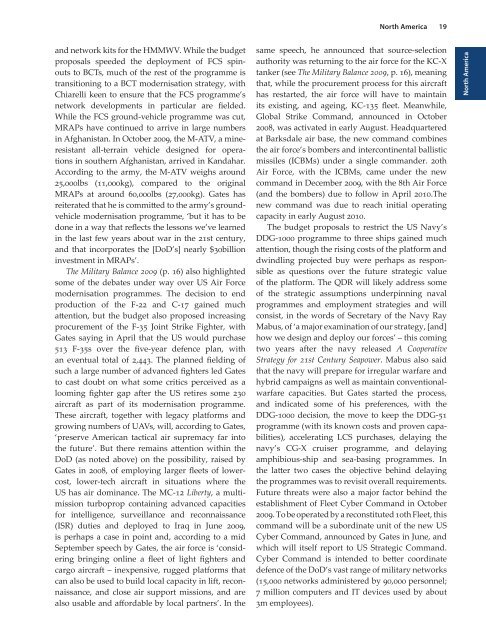You also want an ePaper? Increase the reach of your titles
YUMPU automatically turns print PDFs into web optimized ePapers that Google loves.
and network kits for the HMMWV. While the budget<br />
proposals speeded the deployment of FCS spinouts<br />
to BCTs, much of the rest of the programme is<br />
transitioning to a BCT modernisation strategy, with<br />
Chiarelli keen to ensure that the FCS programme’s<br />
network developments in particular are fielded.<br />
While the FCS ground-vehicle programme was cut,<br />
MRAPs have continued to arrive in large numbers<br />
in Afghanistan. In October 2009, the M-ATV, a mineresistant<br />
all-terrain vehicle designed for operations<br />
in southern Afghanistan, arrived in Kandahar.<br />
According to the army, the M-ATV weighs around<br />
25,000lbs (11,000kg), compared to the original<br />
MRAPs at around 60,000lbs (27,000kg). Gates has<br />
reiterated that he is committed to the army’s groundvehicle<br />
modernisation programme, ‘but it has to be<br />
done in a way that reflects the lessons we’ve learned<br />
in the last few years about war in the 21st century,<br />
and that incorporates the [DoD’s] nearly $30billion<br />
investment in MRAPs’.<br />
The Military Balance 2009 (p. 16) also highlighted<br />
some of the debates under way over US Air Force<br />
modernisation programmes. The decision to end<br />
production of the F-22 and C-17 gained much<br />
attention, but the budget also proposed increasing<br />
procurement of the F-35 Joint Strike Fighter, with<br />
Gates saying in April that the US would purchase<br />
513 F-35s over the five-year defence plan, with<br />
an eventual total of 2,443. The planned fielding of<br />
such a large number of advanced fighters led Gates<br />
to cast doubt on what some critics perceived as a<br />
looming fighter gap after the US retires some 230<br />
aircraft as part of its modernisation programme.<br />
These aircraft, together with legacy platforms and<br />
growing numbers of UAVs, will, according to Gates,<br />
‘preserve American tactical air supremacy far into<br />
the future’. But there remains attention within the<br />
DoD (as noted above) on the possibility, raised by<br />
Gates in 2008, of employing larger fleets of lowercost,<br />
lower-tech aircraft in situations where the<br />
US has air dominance. The MC-12 Liberty, a multimission<br />
turboprop containing advanced capacities<br />
for intelligence, surveillance and reconnaissance<br />
(ISR) duties and deployed to Iraq in June 2009,<br />
is perhaps a case in point and, according to a mid<br />
September speech by Gates, the air force is ‘considering<br />
bringing online a fleet of light fighters and<br />
cargo aircraft – inexpensive, rugged platforms that<br />
can also be used to build local capacity in lift, reconnaissance,<br />
and close air support missions, and are<br />
also usable and affordable by local partners’. In the<br />
North America<br />
19<br />
same speech, he announced that source-selection<br />
authority was returning to the air force for the KC-X<br />
tanker (see The Military Balance 2009, p. 16), meaning<br />
that, while the procurement process for this aircraft<br />
has restarted, the air force will have to maintain<br />
its existing, and ageing, KC-135 fleet. Meanwhile,<br />
Global Strike Command, announced in October<br />
2008, was activated in early August. Headquartered<br />
at Barksdale air base, the new command combines<br />
the air force’s bombers and intercontinental ballistic<br />
missiles (ICBMs) under a single commander. 20th<br />
Air Force, with the ICBMs, came under the new<br />
command in December 2009, with the 8th Air Force<br />
(and the bombers) due to follow in April 2010.The<br />
new command was due to reach initial operating<br />
capacity in early August 2010.<br />
The budget proposals to restrict the US Navy’s<br />
DDG-1000 programme to three ships gained much<br />
attention, though the rising costs of the platform and<br />
dwindling projected buy were perhaps as responsible<br />
as questions over the future strategic value<br />
of the platform. The QDR will likely address some<br />
of the strategic assumptions underpinning naval<br />
programmes and employment strategies and will<br />
consist, in the words of Secretary of the Navy Ray<br />
Mabus, of ‘a major examination of our strategy, [and]<br />
how we design and deploy our forces’ – this coming<br />
two years after the navy released A Cooperative<br />
Strategy for 21st Century Seapower. Mabus also said<br />
that the navy will prepare for irregular warfare and<br />
hybrid campaigns as well as maintain conventionalwarfare<br />
capacities. But Gates started the process,<br />
and indicated some of his preferences, with the<br />
DDG-1000 decision, the move to keep the DDG-51<br />
programme (with its known costs and proven capabilities),<br />
accelerating LCS purchases, delaying the<br />
navy’s CG-X cruiser programme, and delaying<br />
amphibious-ship and sea-basing programmes. In<br />
the latter two cases the objective behind delaying<br />
the programmes was to revisit overall requirements.<br />
Future threats were also a major factor behind the<br />
establishment of Fleet Cyber Command in October<br />
2009. To be operated by a reconstituted 10th Fleet, this<br />
command will be a subordinate unit of the new US<br />
Cyber Command, announced by Gates in June, and<br />
which will itself report to US Strategic Command.<br />
Cyber Command is intended to better coordinate<br />
defence of the DoD’s vast range of military networks<br />
(15,000 networks administered by 90,000 personnel;<br />
7 million computers and IT devices used by about<br />
3m employees).<br />
North America


